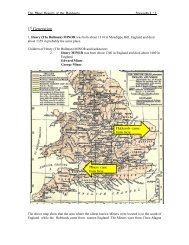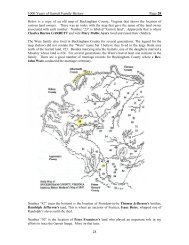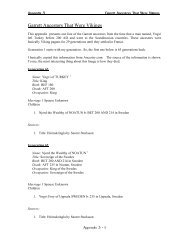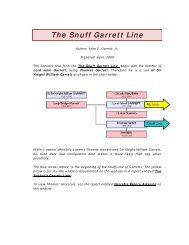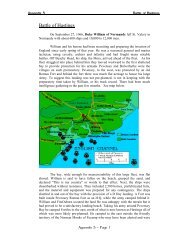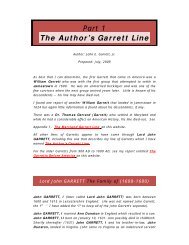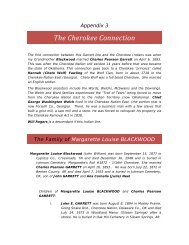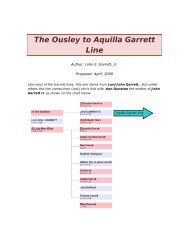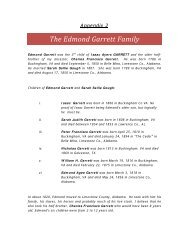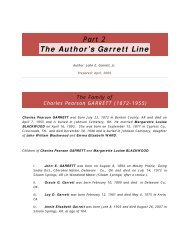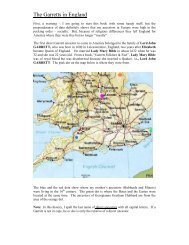The Maryland Garrett Line - Garrett Family Genealogy
The Maryland Garrett Line - Garrett Family Genealogy
The Maryland Garrett Line - Garrett Family Genealogy
You also want an ePaper? Increase the reach of your titles
YUMPU automatically turns print PDFs into web optimized ePapers that Google loves.
<strong>The</strong><br />
<strong>Maryland</strong> <strong>Garrett</strong><br />
<strong>Line</strong><br />
Author: John E. <strong>Garrett</strong>, Jr.<br />
Prepared: April, 2009<br />
In the last half of the 15 th Century, the <strong>Garrett</strong> ancestors divided. One of Sir<br />
Thomas I Gerrard’s sons (Lawrence) went to London and started spelling his<br />
name, Garrard (or <strong>Garrett</strong>), and the other son, Peter, stayed in Bryn and his<br />
descendants dropped one of the “R” in Gerrard.<br />
<strong>The</strong> Lawrence Garrard line went through London, with 3 being Lord Mayors of<br />
London, and then to Lord John <strong>Garrett</strong> and to America. Except for the <strong>Maryland</strong><br />
<strong>Garrett</strong>s, the <strong>Garrett</strong> lines in America came by way of Lord John <strong>Garrett</strong>.<br />
As far as I can tell, the only <strong>Garrett</strong> ancestors that resulted from Peter’s line were<br />
the <strong>Maryland</strong> Gerrards (<strong>Garrett</strong>s). For six generations, Peter’s primary descendants<br />
were named Thomas, so, for clarity I have numbered them Thomas I through<br />
Thomas VI. <strong>The</strong> sixth Thomas immigrated to America; however, many of the<br />
Gerards remained in that part of England. In fact, even today, in Ashton in<br />
Makerfield, there is a Thomas Gerrard School, a Gerard street, a Gerard pub a<br />
Gerard farmer and a Gerard car dealer.
<strong>The</strong> <strong>Maryland</strong> <strong>Garrett</strong> <strong>Line</strong> Page 2<br />
<strong>The</strong> following chart shows Sir Knight Thomas’ family:<br />
<strong>The</strong> yellow arrow leads to my line of <strong>Garrett</strong>s. <strong>The</strong> blue arrow leads to the <strong>Maryland</strong><br />
<strong>Garrett</strong> <strong>Line</strong>.<br />
<strong>The</strong> <strong>Family</strong> of<br />
Sir Peter GERRARD<br />
(1460-1494)<br />
My <strong>Line</strong><br />
<strong>Maryland</strong> <strong>Line</strong><br />
Sir Peter GERRARD of Kingsley and Bryn was born August 13, 1460 in Kingsley,<br />
Runcon, Cheshire, England and died June 20, 1494 in Ponty Pool, Gwent, Wales. He<br />
married Margaret (Margery) Stanley in 1476 in Bryn Kingsley, Frodsham,<br />
Cheshire, England. She was born May 12, 1462 in Hooton, Cheshire, England and<br />
died 1492 in Brynhill Brindle, Chorley, Lancashire, England, daughter of Sir Thomas<br />
Stanley of Hooten, Cheshire and Margaret Bromley.<br />
Children of Sir Peter GERRARD and Margaret (Margery) Stanley:<br />
i. Isabel Gerrard was born 1458.<br />
ii. Jane Gerrard was born 1483 in Bryn, Lancashire, England.<br />
iii. Alice Gerard was born 1485.<br />
iv. Joane Gerrard (alias "Jane Gerard") was born 1487 and died in about<br />
1532.
<strong>The</strong> <strong>Maryland</strong> <strong>Garrett</strong> <strong>Line</strong> Page 3<br />
v. Sir Thomas I of Kingsley and Bryn, GERARD was born January 9,<br />
1488 in Newhall, Ashton, Under Lym, Lancashire, England and died<br />
November 7, 1523 in Berwick-upon-Tweed (Slain fighting Scots).<br />
It is said that Peter Gerard was of Magna Carta Surety, meaning that he was born<br />
of a family that had signed the Magna Carta.<br />
His wife inherited the estate of Bromley of Staffordshire, making his estate.<br />
<strong>The</strong> <strong>Family</strong> of<br />
Sir Thomas I Gerard<br />
(1488-1523)<br />
Sir Thomas I of Kingsley and Bryn, GERARD was born January 9, 1488 in<br />
Newhall, Ashton, Under Lym, Lancashire, England and died November 7, 1523 in<br />
Berwick-upon-Tweed (Slain fighting Scots). He married Margaret Trafford 1510 in<br />
Makerfield, Winwick, Lancashire, England. She was born 1490 in Trafford,<br />
Lancashire, [county], England and died May 10, 1540 in Ponty Pool, Gwent, Wales.<br />
Children of Sir Thomas I of Kingsley and Bryn, GERARD and Margaret<br />
Trafford:<br />
i. Sir Thomas II of Kingsley and Bryn, Gerard was born in<br />
about 1512 in Bryn, West Derby, Lancashire, England and died<br />
July 30, 1540 in burnt as a heretic..<br />
ii. Peter Gerard was born 1514.<br />
iii. Sir William GERARD was born June 19, 1518 in New Hall,<br />
Ashton-in-Makerfield, Lanc, Eng. and died December 19, 1558<br />
in Ponty Pool, Gwent, Wales.<br />
iv. Anne Gerard was born in about 1520 in Of Brynne,<br />
Warwickshire, Eng.<br />
v. James Gerard was born in about 1520.<br />
vi. Henry Gerard was born 1522.<br />
vii. Miles Gerard.
<strong>The</strong> <strong>Maryland</strong> <strong>Garrett</strong> <strong>Line</strong> Page 4<br />
Sir Thomas Gerard, I led the Lancashire archers at Flodden Field in 1513. Died at<br />
Berwick Nov. 7, 1523/26 in Scottish wars.<br />
Sir Thomas Gerard, I succeeded his grandfather and was killed in the wars of<br />
Berwick. He left nine children, five sons and four daughters. Only Thomas and Pyers<br />
(Peter) were specifically named as sons when friends of Thomas who were with him<br />
in the wars testified regarding his dying wishes for his four younger.<br />
His son, Thomas II (of Kingsley and Bryn), Gerard was born in about 1512. He<br />
married Jane Legh, daughter of Sir Peter Legh (Lee) of Haydock, Co. of Lancaster.<br />
On July 30, 1540 Thomas Gerard II, a convert to the doctrines of Luther, was<br />
imprisoned in the Tower, then taken by hurdle to Smithfield and burnt as a heretic.<br />
<strong>The</strong> <strong>Family</strong> of<br />
Sir William Gerard<br />
(1518-1558)<br />
Sir William GERARD was born June 19, 1518 in New Hall, Ashton-in-Makerfield,<br />
Lanc, Eng. and died December 19, 1558 in Ponty Pool, Gwent, Wales. He married<br />
Constance Rowson in about 1529 in Lancashire, England. She was born in about<br />
1510 in England and died in about 1567 in England.<br />
Child of Sir William GERARD:<br />
i. Sir Thomas (the bastard) III GERARD was born 1537 in<br />
Bryn, West Derby, Lancashire, England and died September<br />
1601 in Mynwich Church, Lancashire, England.<br />
William Gerard, the third son of Thomas Gerard and Margaret Trafford had no<br />
title, but he was considered a Gentleman. He succeeded to the family inheritance<br />
from his brother Sir Thomas Gerard, II who was a Knight and High Sheriff of<br />
Lancashire. <strong>The</strong>re was a brother in between named John, and John was a priest.
<strong>The</strong> <strong>Maryland</strong> <strong>Garrett</strong> <strong>Line</strong> Page 5<br />
<strong>The</strong>re are court papers telling about how Newhall succeeded to William. Thomas was<br />
the bastard child of William Gerard. Thomas, uncle of Thomas and Brother of William<br />
was the inheritor of the estate but he agreed with William before his death to leave<br />
Newhall to William's baseborn son, Thomas Gerard, III.<br />
Interestingly enough Peter Leigh, Esq. is named in these depositions. Constance<br />
Rowson, wife of William appeared to give a deposition. All in all, Thomas Gerard of<br />
Bryn gave his younger brother William, and William's illegitimate son life tenancy in<br />
the New Hall in 1543. William died before 1560, while his son Thomas was still a<br />
minor. Because he was a minor his uncle James occupied the home at New Hall.<br />
<strong>The</strong> <strong>Family</strong> of<br />
Sir Thomas III GERARD<br />
(1537-1601)<br />
Sir Thomas (the bastard) III GERARD was born 1537 in Bryn, West Derby,<br />
Lancashire, England and died September 1601 in Mynwich Church, Lancashire,<br />
England. He married Elizabeth Port 1559 in Bryn, Lancashire, England. She was<br />
born 1540 in Ashton, Makerfield, Lancashire, England and died 1632 in Lancaster,<br />
England.<br />
Children of Sir Thomas (the bastard) III GERARD and Elizabeth Port:<br />
i. Sir Knight Thomas IV (Baron of Bryn) GERRARD was born<br />
1560 in Bryn, Winwick. Lancashire, England and died February<br />
16, 1620 in Lancaster, England.<br />
ii. Alexander Gerard was born 1561.<br />
iii. John the Jesuit Priest Gerard was born October 4, 1564 and<br />
died July 17, 1637 in English College in Rome.<br />
iv. Nicholas Gerard.<br />
v. Mary Gerard was born 1556.<br />
vi. Marytha Gerard was born 1558.<br />
Notes on Sir Thomas (the bastard) III GERARD
<strong>The</strong> <strong>Maryland</strong> <strong>Garrett</strong> <strong>Line</strong> Page 6<br />
Thomas III Gerrard of Kingsley and Bryn also got into trouble. During his life,<br />
there was a plot to rescue Mary, Queen of Scots when she was imprisoned at<br />
Tutbury, Staffordshire, a few miles from Bryn, and to take her to the Isle of Man.<br />
<strong>The</strong> beginnings of the plot to place a Scottish monarch on the throne of England can<br />
be traced to the year 1569 when Thomas III got involved at the age of 29. Two<br />
years later, Thomas III was imprisoned in the Tower of London. On Thomas III’s<br />
release in 1573, he took his children back to Bryn. <strong>The</strong> price he paid for his freedom<br />
was the enforced sale of his Manor at Bromley to his cousin, Sir Gilbert Gerard, the<br />
Attorney General.<br />
From August 1586 to October 1588, Sir Thomas III was again imprisoned for<br />
supposed complicity in the Babbington plot to kill Queen Elizabeth and place Mary on<br />
the throne. On his release, he seems to have given up the practice of his faith,<br />
though he returned to it before his death in 1601. <strong>The</strong> family thereafter remained<br />
staunchly Catholic and loyal to the Stuart cause.<br />
Thomas III’s, son, John Gerard was a Jesuit Priest and in 1585 was imprisoned in<br />
<strong>The</strong> Tower of London for attempting to leave England without license. On release he<br />
went to Rome. In 1588, John Gerard returned to England, was betrayed by a<br />
servant (named Thomas Bates, possibly an ancestor of my wife, Frances), and<br />
committed to the Tower and tortured. With the help of John Arden, a Roman<br />
Catholic priest and also a prisoner, he escaped from the Tower in 1597. He was later<br />
suspected of complicity in the Gunpowder Plot, and escaped to Rome in 1606.<br />
Thomas III’s son, Nicholas Gerard had a daughter, Margery, who married Robert<br />
Arrowsmith of Haydock. <strong>The</strong>ir son, Bryan took the name Edmund Arrowsmith<br />
and became a priest. He was martyred at the age of 43 on August 28, 1628. In a<br />
strange ritual under cover of night, Sir Thomas III and other family members<br />
accompanied by the family priest who was armed with a knife and slipped in where<br />
the body was secreted and severed his right hand which is held in great veneration<br />
with other memoirs of Arrowsmith.<br />
Thomas III,s son, Thomas Gerrard, IV (born 1560), was made a Baron, (thus<br />
becoming Baron Thomas Gerrard) and received back the fee (extracted from his<br />
father) in consideration of “the sufferings of his father on behalf of Queen Mary”.<br />
He was knighted on April 18, 1603, (becoming Sir Knight Baron Thomas Gerrard<br />
IV) and was created a baronet May 22, 1611 by King James I, free of charge, in<br />
recognition of his father's services to Mary Stuart. Thomas IV’s brother, John<br />
Gerard’s, comment upon hearing of his brother's knighthood said, "It was really no<br />
great advancement for him as the family has been thus for sixteen centuries."
<strong>The</strong> <strong>Maryland</strong> <strong>Garrett</strong> <strong>Line</strong> Page 7<br />
<strong>The</strong> <strong>Family</strong> of<br />
Sir Knight Thomas IV GERRARD<br />
(1560-1620)<br />
Sir Knight Thomas IV (Baron of Bryn) GERRARD was born 1560 in Bryn,<br />
Winwick. Lancashire, England and died February 16, 1620 in Lancaster, England. He<br />
married 1st (1) Cecily Maney 1580 in Lancaster, England. She was born 1560 in<br />
Staplehurst, Kent, England . He married 2nd (2) Mary Hawes. She was daughter<br />
of Sir James Hawes, Lord Mayor of London and (unknown). He married 3rd (3)<br />
Mary Dormer in April 1606 . She was born 1555 in Eythorpe, Buckshire, England<br />
and died 1637 in Midhurst, Sussex, England.<br />
Children of Sir Knight Thomas IV (Baron of Bryn) GERRARD and (1) Cecily<br />
Maney:<br />
i. Sir Thomas V (2nd Baron of Bryn) GERRARD was born<br />
1580 in Ashton, Lancashire, England and died May 15, 1630 in<br />
Winwick, Lancashire, [county], England.<br />
ii. Frances Gerrard.<br />
Notes on Sir Knight Thomas IV (Baron of Bryn) GERRARD<br />
Sir Thomas Gerard IV of Bryn, born 1560 and buried 16 February 1620-1, was<br />
knighted in 18 April 1603, created a baronet 22 May 1611 by James I, free of<br />
charge, in recognition of his father's services to Mary Stuart. He had only one son,<br />
Thomas. He was married three times. First to Cecily Maney, mother of his children<br />
and daughter of Sir Walter Maney; secondly, Mary Hawes, daughter of Sir Thomas<br />
Hawes, and widow of John Smythe; and thirdly to Mary Browne, daughter of William<br />
Browne, widow of William Downer, Esq.<br />
Thomas IV and his brother, Alexander, matriculated from Brasenose College to<br />
Oxford on the same date, July 20, 1578. Sir Thomas IV received his M.A. at<br />
Cambridge in 1612 (on the King's visit) as "Jarrard.". Thomas IV's sons and<br />
grandsons were educated at Oxford, Cambridge. Douai, Rheims, and the Jesuit<br />
College in Paris as were other Gerard sons thus incurring the wrath of the Queen for<br />
their exposure to the "Popish" religion.
<strong>The</strong> <strong>Maryland</strong> <strong>Garrett</strong> <strong>Line</strong> Page 8<br />
In 1603, King James 1, son of Mary, Queen of Scots; on his way to London<br />
expressed his gratitude to Thomas IV for the family's loyalty to his mother. "I am<br />
particularly bound," he said, "to love your blood on account of the persecution you<br />
have borne for me.<br />
On the 16th of December, 1580, the Council wrote "the Queen finds great<br />
inconvenience growing by the education of great numbers of young gentlemen and<br />
other subjects beyond the sea, where they are accustomed and nourished in papistry<br />
with instructions making them dislike the government and on reaching home<br />
refusing to yield obedience to the laws and matters of religion, and by their evil<br />
religion corrupt others, the contagion spreading so far, as, if not remedied, to be<br />
dangerous to the Queen and state." She, therefore, "intending to take orders that<br />
children shall be prohibited from departing out of the realm except by special license;<br />
as also by recalling those now in Spain, Italy, France, etc." Among those named<br />
abroad without license were sons of the Gerards,<br />
On Thomas IV’s death, he owned the following property:<br />
Messuage (house) called 1e Bryn<br />
Manor of Ashton in Makerfield with<br />
130 messuages,<br />
60 cottages,<br />
2 windmills,<br />
4 watermills,<br />
1300 acres of land;<br />
300 acres of meadow;<br />
3000 acres of pasture;<br />
100 acres of wood and underwood;<br />
20 acres of land covered by water;<br />
40 acres of moor and moss;<br />
300 acres of marsh and<br />
40 shillings rent in Bryn and Ashton in Makerfield<br />
Manor of Windle with<br />
70 messuages,<br />
40 cottages,<br />
70 acres of land;<br />
100 acres of meadow;<br />
1000 acres of pasture; 20 acres of wood and underwood;<br />
300 acres of moor, moss, and marsh; and<br />
10 shillings of rent in Windle;
<strong>The</strong> <strong>Maryland</strong> <strong>Garrett</strong> <strong>Line</strong> Page 9<br />
30 acres of land, meadow, and pasture<br />
In Ince, with<br />
5 messuages;<br />
5 gardens;<br />
5 orchards; and<br />
5 acres of land<br />
It is believed that he financed his descendants and relatives in education and<br />
immigration to America.<br />
<strong>The</strong> <strong>Family</strong> of<br />
Sir Thomas V GERRARD<br />
(1580-1630)<br />
Sir Thomas V (2nd Baron of Bryn) GERRARD was born 1580 in Ashton,<br />
Lancashire, England and died May 15, 1630 in Winwick, Lancashire, England. He<br />
married Frances Molyneux in 1610 . She was born in about 1592 in Sefton,<br />
Lancashire, England and died February 28, 1613 in Winwick, Lancashire, England,<br />
daughter of Sir Richard Molyneux, 1st Baron of Sefton and (unknown).<br />
Children of Sir Thomas V (2nd Baron of Bryn) GERRARD and Frances<br />
Molyneux:<br />
i. Dr. Thomas VI GERRARD was born December 10, 1608 in<br />
Newhall, Lancashire, England and died February 1, 1672 in<br />
Westmoreland Co, Virginia.<br />
ii. Richard Gerrard, cup bearer to King James was born 1612<br />
and died 1686.<br />
iii. Anne Gerrard was born in about 1608 in Lancashire, England<br />
and died 1637 in St. Mary County, MD. She married Governor<br />
Thomas Greene.<br />
iv. William (3nd Baron of Bryn) Gerard was born in about 1612<br />
in Daniel, Kemp, Lancashire, England. and died April 7, 1681 in
<strong>The</strong> <strong>Maryland</strong> <strong>Garrett</strong> <strong>Line</strong> Page 10<br />
Winwick, Huntingdonshire, England. He was involved in the<br />
inquisition held in 1637<br />
v. Sir Gilbert Gerard was born in about 1612 and died<br />
September 24, 1687, unmarried.<br />
vi. Peter Gerard was born in about 1614. He died unmarried.<br />
vii. John Gerard was born in about 1616. He died unmarried<br />
viii. Frances (the Nun) Gerard was born in about 1618. She<br />
became a nun.<br />
Thomas V’s, second son Richard Gerard was born in 1612 and went to America in<br />
1634 with the Calverts. aboard <strong>The</strong> Ark and the Dove. Richard, who had been the<br />
Cup Bearer to King James did not stay in America but instead returned to England<br />
where he became a distinguished soldier and died on September 5, 1686. Upon his<br />
return, he purchased the Manor of Ince from his cousin Thomas Gerard. <strong>The</strong>re he<br />
died in 1686.<br />
<strong>The</strong> Ark and the Dove<br />
Thomas V’s oldest daughter, Anne Gerard was born in about 1610 and was a widow<br />
when she immigrated to <strong>Maryland</strong> with her brother, Richard. She was to become
<strong>The</strong> <strong>Maryland</strong> <strong>Garrett</strong> <strong>Line</strong> Page 11<br />
the 2 nd wife of Thomas Greene, Governor of the Province of <strong>Maryland</strong> within 2<br />
years and would bear them two sons, Leonard and Thomas. She died early in 1637.<br />
Thomas V’s daughter, Frances Gerrard, became a Nun at Gravelines in Flanders.<br />
Thomas V’s third son, Sir William Gerard of Garswood and Bryn, was born in<br />
1611 and was a Baronet. He was 19 years old when his father's died, and 26 years<br />
old at the inquisition held in 1637. He expended a large estate in the reign of King<br />
Charles I and lost considerable property by sequestration. (<strong>The</strong> State seized<br />
property as a means of enforcing a degree for the payment of money from these<br />
Catholic families.) He was buried April 7, 1681.<br />
Sir William married Elizabeth, daughter of Sir Cuthbert and Alice Clifton, Knight of<br />
Lytham and Westby. He had four sons, all of whom attended an English Jesuit<br />
School, St. Omer's College, at Saint Omer in Spanish Flanders, founded in 1593.<br />
(Flanders is now Vlaanderen, Belgium.) <strong>The</strong> school was forced to move to Bruges,<br />
Austria in the Netherlands in 1762 because of attacks on the Jesuits in France. (St.<br />
Omer's was then on French Territory.) Boys with a view to entering the priesthood<br />
attended St. Omer's and a large proportion of them actually did become priests.<br />
William's sons attended St. Omer's as follows: William, 1650-54; Cuthbert, 1656-62;<br />
John 1658-52 or later; and Thomas, who became a priest, 1660-62 and died in<br />
1682.<br />
Thomas V’s fourth son, Gilbert Gerard attended St. Omer's 1629-34 and became a<br />
Catholic priest. He died in 1645. Ships passenger lists show that Gilbert Gerard<br />
went to Virginia in 1643 and Peter Gerard, (Gilbert’s brother) went to America in<br />
1653.<br />
Thomas V’s oldest son was Dr. Thomas VI of Newhall, Gerard was born on<br />
December 10, 1608 in Newhall, Lancashire. He immigrated to <strong>Maryland</strong> in 1637,<br />
three years after his brother, Richard, and sister, Anne.
<strong>The</strong> <strong>Maryland</strong> <strong>Garrett</strong> <strong>Line</strong> Page 12<br />
<strong>The</strong> <strong>Family</strong> of<br />
Dr. Thomas VI GERRARD<br />
(1608-1672)<br />
Dr. Thomas VI GERRARD was born December 10, 1608 in Newhall, Lancashire,<br />
England and died February 1, 1672 in Westmoreland Co, Virginia<br />
<strong>The</strong>re is evidence that Thomas VI married twice in England before immigrating to<br />
America. <strong>The</strong> first wife was named Frances Mullinlear. <strong>The</strong> second wife was Alice<br />
Parran who died before 1637. He married Susannah Snow in 1643 in St. Mary's<br />
<strong>Maryland</strong>. She was born 1610 in Lockhamstead, Buckinghamshire, England and died<br />
in <strong>Maryland</strong>. After, Susannah Snow’s death, he married Virginia Rose Tucker.<br />
Children of Dr. Thomas VI GERRARD and Susannah Snow:<br />
i. Elizabeth Gerrard was born in about 1632.<br />
ii. Capt. Justinian Gerrard was born 1634 in Bryn, Winwick.<br />
Lancashire, , England and died 1688 in St. Mary's City, MD.<br />
iii. Thomas Gerrard was born in about 1636.<br />
iv. Frances Gerrard was born 1640.<br />
v. Anne Gerrard was born 1642.<br />
vi. Patience Gerrard was born in about 1643.<br />
vii. John Gerrard was born in about 1644 in St. Mary's County,<br />
MD and died Before 1678 in Westmoreland Co, Virginia.<br />
viii. Janette Gerrard was born in about 1645.<br />
ix. Mary Gerrard was born Before 1647.<br />
x. Judith Gerrard was born in about 1649.<br />
xi. Rebecca Gerrard was born in about 1651.
<strong>The</strong> <strong>Maryland</strong> <strong>Garrett</strong> <strong>Line</strong> Page 13<br />
<strong>The</strong> last quarter of the 16th century witnessed the beginning of a Catholic exile<br />
movement to America. As early as 1574 Sir Humphrey Gilbert, half-brother of Sir<br />
Walter Raleigh, conceived a plan of colonization which was to have the support of<br />
two Catholic gentlemen, Sir George Peckham and Sir Thomas IV Gerard<br />
At the time of this venture there was in force a statue called "An Act against<br />
Fugitives over the Sea", which was designed to prevent the migration of Catholic<br />
recusants<br />
On June 11th 1583, Sir Humphrey's fleet of five ships and some two hundred men,<br />
including Catholic recusants, sailed from Plymonth and reached Maine on August<br />
20th. On their return trip at midnight on September 9th, during a heavy storm, Sir<br />
Humphrey's ship with all on board went down.<br />
Nothing eventful happened until --After much preparation the Ark and the Dove<br />
spread its sails in the early morning of November 22nd, 1633. <strong>The</strong> departure was<br />
from Cowes on the Isle of Wight.<br />
<strong>The</strong> first effort to form a colony failed but the next effort succeeded when on<br />
February 24th, 1634 a group (including one of Thomas V’s sons and daughters)<br />
sailing in the Ark and the Dove dropped anchor at Point Comfort, Virginia. <strong>The</strong>y<br />
were there several days and then entered the Chesapeake and reached the Potomac.<br />
On St. Clement Island these <strong>Maryland</strong> colonists made their first landing on March<br />
25th 1634. On the modern map, below, St. Clement Island is the bottle shaped<br />
island just South of Coltons Point, <strong>Maryland</strong>. It is in the Potomac River.
<strong>The</strong> <strong>Maryland</strong> <strong>Garrett</strong> <strong>Line</strong> Page 14<br />
<strong>Maryland</strong> historians have given scant attention to Dr. Thomas VI Gerard although<br />
he was an important political figures and the largest landholders in the province<br />
during the period 1637-1673.<br />
A timeline for Dr. Thomas Gerard is as follows:<br />
1637 arrived in <strong>Maryland</strong><br />
1638 elected burgess from St. Mary's Hundred<br />
1639 appointed by Cecilius, second Lord Baltimore, conservator of the<br />
peace for St. Clement's Hundred<br />
1639 St. Clement's manor grant made to Gerard
<strong>The</strong> <strong>Maryland</strong> <strong>Garrett</strong> <strong>Line</strong> Page 15<br />
1641 chosen burgess from St. Clement's Hundred<br />
1643-1659 appointed by Lord Baltimore as member of Provincial<br />
Council & Judge of Provincial Court<br />
1650 patent 1000 acres Northum.<br />
1654-1656 Captain for Governor Stone during Puritan uprising/<br />
captured<br />
1659-1660 participation in Fendall's Rebellion and banishment to<br />
Virginia<br />
1660 or 1661 pardon granted and return to <strong>Maryland</strong><br />
1666 death of first wife SUSANNAH, moved back to Virginia<br />
1667 married Rose Tucker<br />
1673 died in Westmoreland County but buried back at Longworth<br />
Point, MD.<br />
Dr. Thomas VI Gerard, on October 29th, 1639, requested a land grant for<br />
transporting himself and five able men into the province. On March 30th, 1640 a<br />
survey of 1,000 acres of land lying to the north of St. Clement's Manor where the<br />
town of Matapania now stands and including the island of St. Catherine's Creek<br />
called St. Catherine's Island was made for Thomas. Other of his land possessions,<br />
taken from the rent rolls of St. Mary’s County from 1639 to 1724 are: St. Clement's<br />
Manor, St. Clement's Island, 11,400 acres granted to him by Lord Baltimore in 1638-<br />
9 and was surveyed by Justinian Gerard, his eldest son in 1678, Gerard's Freehold,<br />
243 acres in St .Mary's Hundred, St. Winefreides Freehold in Charles County,<br />
Wiccocomico, 550 acres surveyed for him in 1666, Westwood Manor, surveyed in<br />
1651. In all there are 32,343 acres. Some of the place names were: Bromley,<br />
Chaptico, River View, Bushwood, Hackley, Little Hackley, Waterloo, Dukehard,<br />
Branton, Longworth Point, and Chancellor Point.<br />
<strong>The</strong> first owners of what is now called Capitol Hill, Washington, D.C. were George<br />
Thompson and Dr. Thomas Gerard, who patented the land jointly under several<br />
titles in 1663. One hundred and twenty seven years later the land was purchased by<br />
the Federal Government,
<strong>The</strong> <strong>Maryland</strong> <strong>Garrett</strong> <strong>Line</strong> Page 16<br />
Dr. Thomas Gerard was one of the first doctors or "chirurgeons" in the province.<br />
In 1639, he was appointed conservator of the peace for St. Clement’s Hundred. In<br />
1641 he was chosen burgess from St. Clements and two years later, appointed as<br />
member of the Provincial Council & Judge of Provincial Court. Other appointments<br />
and commissions followed, such as one to look after his Lordship's property and<br />
another to advise concerning Indian problems.. Gerard continued as a member of<br />
the Council until the time of Fendall's Rebellion in 1659 and also served as a Judge of<br />
the Provincial Court during this period.<br />
Gerard was not only active in the practice of medicine, member of Council and Court,<br />
but was also an able farmer, a manufacturer of liquors, particularly peach brandy,<br />
and a breeder of fine cattle. Apparently, he was also an excellent sailor from the<br />
many trips that he made by boat between Longworth Point and St. Mary's City.<br />
During the Puritan uprising (1654-1656) Gerard was appointed one of Governor<br />
Stone's captains. He took part in the battle at Herring Creek where he was captured<br />
with the rest of Stone’s force. Although quarter had been promised, four of the men<br />
were executed by the Puritans and Gerard narrowly escaped with his life. After the<br />
difficulties with the Puritans had been resolved, Gerard returned to his duties as a<br />
member of the Council under the governorship of Josias Fendall.<br />
Dr. Thomas Gerard patented 1,000 acres south of the Potomac River on October<br />
18, 1650 in Westmoreland County, Virginia. He moved there after he lost his<br />
<strong>Maryland</strong> estates in the revolution of 1659 under his friend, Josias Fendall. To<br />
protest certain taxes that they thought unfair, the Assembly issued the first<br />
declaration of Independence in America and Governor Fendall proclaimed <strong>Maryland</strong><br />
a republic – which started the revolution of 1659.<br />
However, the rebellion collapsed in 1660, and Lord Baltimore, in a furious letter<br />
dated August 24, 1660, instructed his brother Philip Calvert, then governor, to deal<br />
harshly with GERARD, FENDALL, HATCH, SLYE and others who took a leading part in<br />
the revolt. <strong>The</strong>y could be sentenced to death, be banished from the province and<br />
suffer the loss of all their property. Gerard's manor lands and other property were<br />
seized, and he was banished. He retired temporarily to his lands across the Potomac<br />
in Westmoreland County, Virginia, a 3,500 acre holding, known as Gerard Preserve.<br />
In a few months, however, he applied to the <strong>Maryland</strong> Council for a pardon which<br />
was promptly granted. He was restored to citizenship in the Province but forbidden<br />
to hold office or to have a voice in elections. His lands and other property were<br />
restored to him.
<strong>The</strong> <strong>Maryland</strong> <strong>Garrett</strong> <strong>Line</strong> Page 17<br />
After the restoration of his estates, Gerard returned to live in <strong>Maryland</strong>, where he<br />
continued his practice as a physician, looked after his lands, and completed more<br />
sales of property. His large family consisted of three sons and seven daughters. He<br />
had many friends on both sides of the Potomac River, and several of his daughters<br />
married Virginians. In addition to enjoying the favorite provincial drink of "burnt<br />
brandy," GERARD was not averse to cards and dice.<br />
Later, Dr. Thomas Gerard returned to his land in Virginia where together with Henry<br />
Corbin, John Lee, son of Col. Richard Lee, then deceased, and Isaac Allerton, they<br />
built a "Banqueting House" at or near the head of Cherive’s (now Jackson’s) Creek,<br />
where their estates joined. It was agreed that each party to the contract should<br />
"yearly, according to his due course, make an honorable treatment fit to entertain<br />
the wives, heirs, neighbors and friends”.<br />
All neighbors were, however, not so friendly. Two, Richard and his wife, Anna Cole,<br />
were of a type not frequent in Virginia. In 1664 Mrs. Cole had been committed to the<br />
custody of the sheriff "upon suspicion of the murder of Rose Parker". Of this charge<br />
she must have been acquitted, but she did not bridle her tongue and evidently the<br />
Coles looked upon Dr. Thomas Gerard and his two daughters, Anne and Frances,<br />
as enemies and in due time the Gerard's had to bring charges of libel against Mrs.<br />
Cole. It appears the Gerards won the case. John Washington was one of the<br />
Justices of the Court.<br />
Dr. Thomas Gerard died on February 1, 1672 at the age of 64 at his home in<br />
Westmoreland County, VA. By his request he was buried “as close as possible” to his<br />
first wife, Susannah which was at his home across the Potomac at Longworth Point,<br />
<strong>Maryland</strong>. On the map on page 4, Longworth Point is now call Colton’s Point. <strong>The</strong>re<br />
is today, a street at that location named “Gerrard Lane”. <strong>The</strong> Gerard private<br />
cemetery existed until the early 1900’s when the owner of surrounding land threw<br />
the tombstones over the cliff and into the Potomac. Not satisfied with this<br />
desecration, it has been reported that a guest at the local hotel was allowed to open<br />
the graves and remove a skull. In a terrific storm in the summer of 1933 the hotel<br />
was wrecked and much ground washed away so that now there is no evidence<br />
whatsoever of the original Gerard home or burial grounds.<br />
Dr. Thomas Gerard’s daughter, Anne Gerard became the 2 nd wife to Col. John<br />
Washington, the Great Grand Father of President George Washington. When
<strong>The</strong> <strong>Maryland</strong> <strong>Garrett</strong> <strong>Line</strong> Page 18<br />
Anne died, her sister Frances became the 3 rd wife to President George<br />
Washington’s great grand father.<br />
None of Dr. Thomas Gerard’s three sons long survived him. John died first in 1678<br />
leaving a son John (who had no sons) and a daughter, Rebecca who married<br />
Charles Calvert (Governor of <strong>Maryland</strong> form 1720 to 1727). After John’s death this<br />
line of the Gerard family became extinct.



